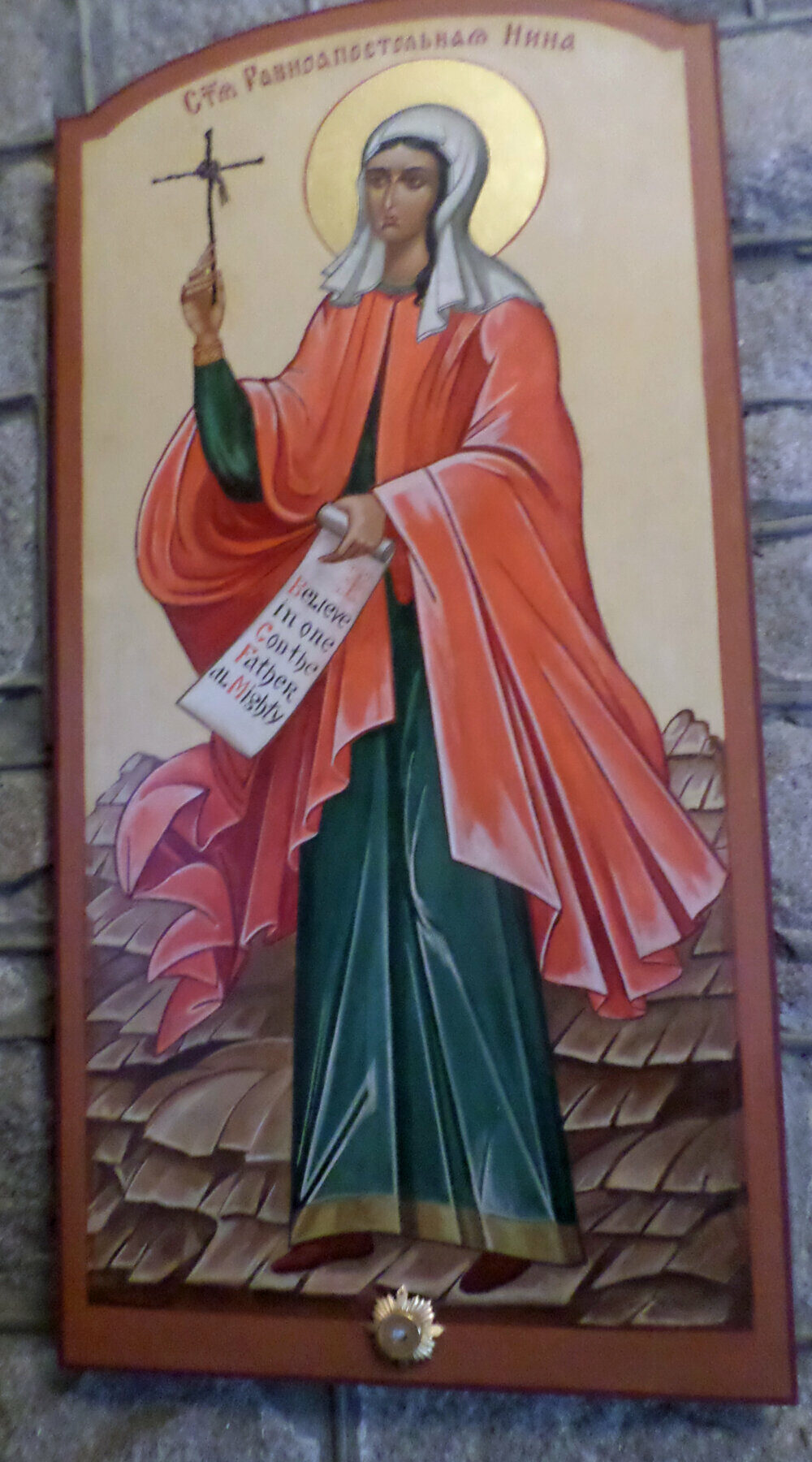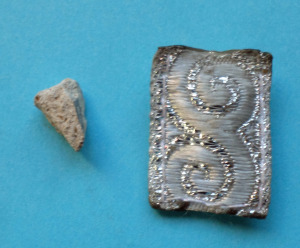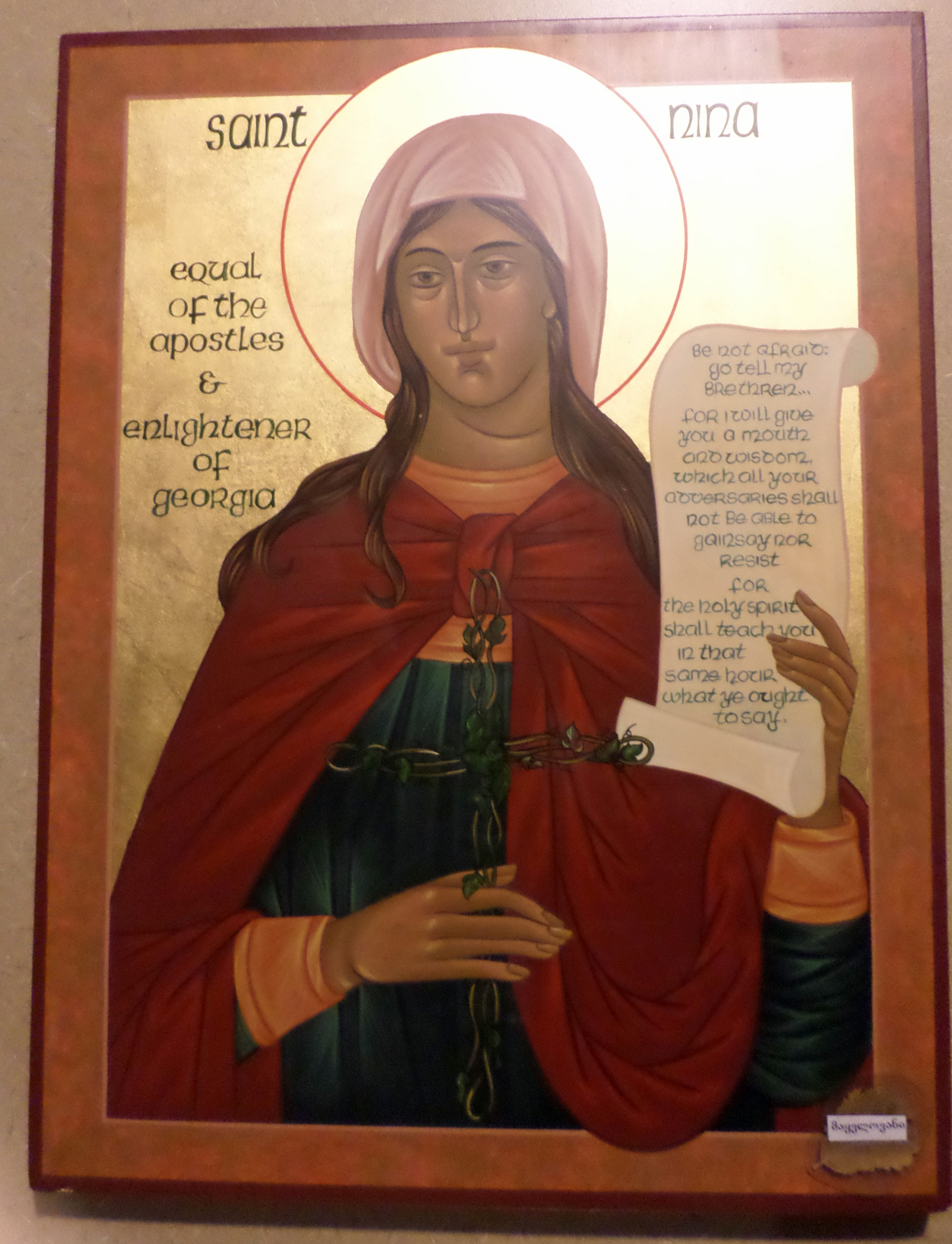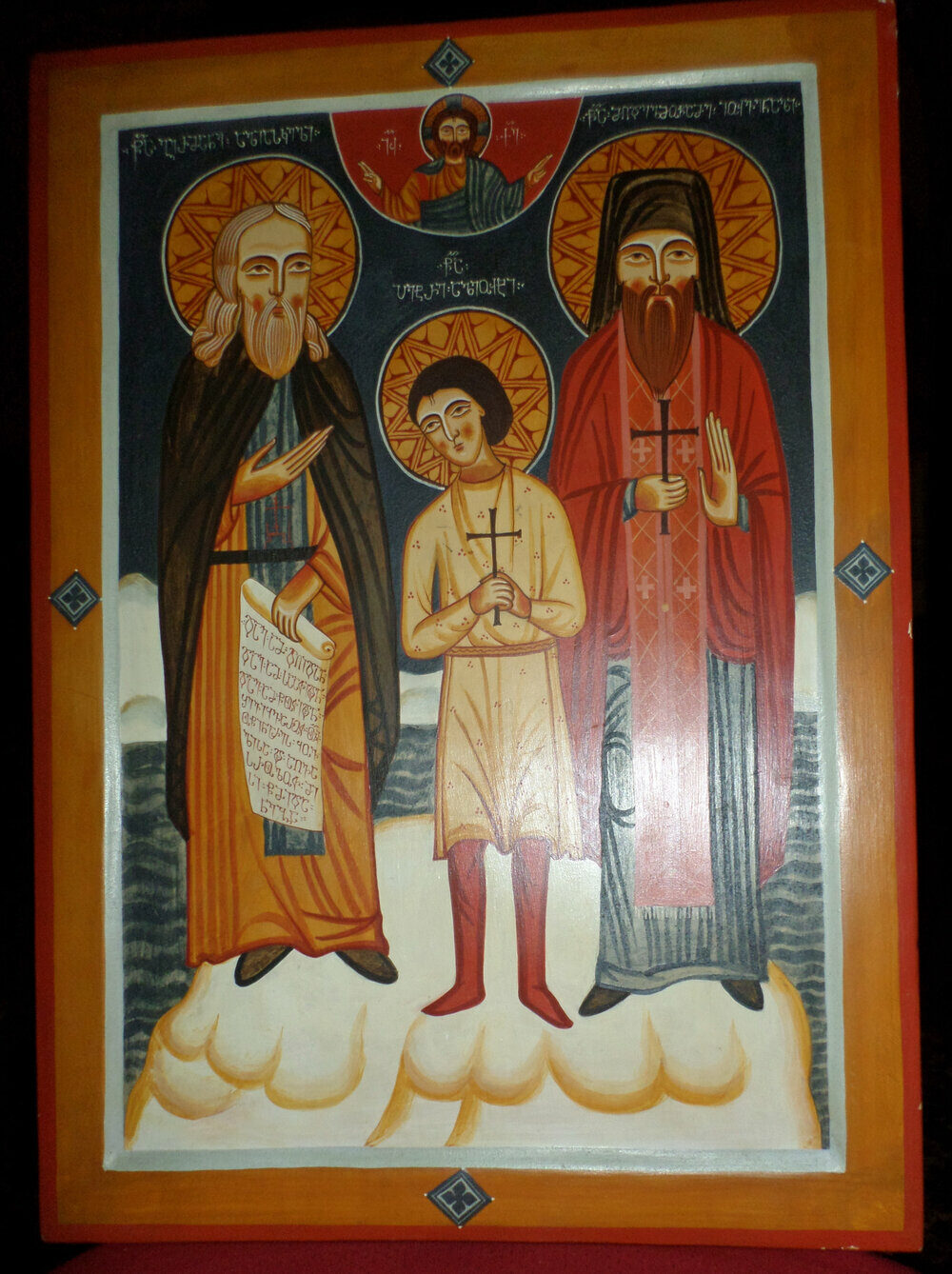[January 25, 2016]
Over the years we have seen some touching and marvelous things occur at Holy Cross Church. Here are a few of our stories.
1. We’ve had a couple of “angel sightings” by very young children. (Or rather, a couple that children told us about; who knows how many times they see angels, and don’t tell us about it.)
On a Sunday in 1999, a family from Texas came to Holy Cross for the Divine Liturgy, accompanied by their 3-year-old girl. Later that day they were at dinner in Deacon Mark & Shmassey (“deacon’s wife”) Ina O’Dell’s home. The little girl was seated between her mother and Ina, and Fr. Gregory was seated across the table from them. Ina says:
“I remember her sitting there between me and her mom saying, ‘Mom! Look, he’s the one!’, while pointing to Fr. Gregory. Her mother asked what she meant, and she said ‘He’s the one that was singing with the angels!’ Beth looked at me with raised eyebrows. One of us asked the child whether she had seen angels in church, and she replied ‘Yes,’ but she was clearly more excited to be seeing Father again: ‘and he’s the one that was singing with them!’”
2. At the Vesperal Divine Liturgy for the Feast of the Transfiguration, August 5, 2010, I was holding my granddaughter Ruthie, then about two and a half years old. The service reached the point of the Cherubic Hymn, and Ruthie and I were standing directly in front of the Royal Doors, with a full view of the altar.
When Fr. Gregory began to cense around the altar, Ruthie was suddenly overwhelmed. She stared wide-eyed at the scene, and laughed with amazement and delight. She exclaimed over and over: “At the same time! At the same time!”
All I could see was my husband going around the altar, like he always does. But she could see something else, something happening “at the same time,” and it must have echoed his movements in a glorious way. Ruthie would pause and grasp for other words to try to describe what she was seeing, then return to the only ones her toddler-sized vocabulary could supply: “At the same time!”
Here’s a more-mysterious one. When Ruthie was younger, at Holy Cross and also at her church in Tennessee, she would at times face the altar and hold up her hands side-by-side, then pat the air with them in a descending gesture. Perhaps she saw ranks of angels “falling down” in worship.
3. On Thursday evening, January 2, 2014, Ben Anderson was serving the Paraklesis Hymn with only three other parishioners present (Fr. Gregory was out of town). At one point, Ben heard a deep male voice begin chanting the ison with perfect pitch. He wondered if it was Michael Lunz, who had come in and joined them. But when he asked afterward, Michael said it was not him, nor was it any of the others attending. No one visible had been chanting the ison. (I’ve heard stories like this at other churches.)
4. Holy Cross partners with local charities every year for “Holiday Sharing,” giving Christmas gifts to needy families. There are two separate groups we work with, focusing on one or the other each year. On Sunday December 21, 2014, after worship, we were shocked to learn that the second charity thought that we were supplying gifts to them as well. They were planning to come by and pick up the gifts in a couple of hours. Holy Cross needed to provide 32 gifts, two for each age child, from one to sixteen.
Father Gregory was about to send Binyam (now Monk Michael) Abeye to the store to buy gifts, when a truck pulled into Holy Cross parking lot. As Elaine Papp tells the story, he asked if we needed any toys for children. He explained that his boss was very wealthy, and every year his children receive more gifts than they can use. So, before Christmas every year, they gather up all the unused, unopened toys and give them away. The driver said he had been on his way to the Salvation Army, but had gotten lost (there is no Salvation Army within 10 miles). When he saw Holy Cross, he said, he wondered if we could use them.
The toys were still new and in their original packaging, and there were more than enough to meet the needs of the second charity. Somehow no one managed to get the truck driver’s name before he left, but Mitch Glassman’s theory is it was “Nick.”
5. One Sunday, during the Great Entrance procession, Subdeacon Craig Ephraim Roseland was walking backwards in front of the clergy, swinging the censer. Somebody bumped it, and some of the burning coals spilled out onto the red Oriental rug. They began to glow and smolder, sinking down into the rug’s surface.
I was standing nearby, and as the procession continued on, I tried to think of the fastest way I could get some water. This happened near the choir director’s stand, and I thought of asking Colleen Oren if she had any water. She hadn’t seen the incident, so had no idea why I was asking this, but when I kept insisting she passed me her bottle of water. I poured it onto the smoldering coals.
This kind of accident usually leaves a number of roundish, charred indentations wherever the coals land (you can see some on these on the solea carpet, in front of the Royal Doors). We didn’t do anything more at the moment, just continued the service, but after the Liturgy Father and I went to look at the rug and find out how badly it had been damaged.
Though we looked at it closely, we couldn’t find any signs of the accident. We couldn’t even find the place where I had poured the water. It was as if it had never happened.
6. In September 2014, Aidan Mejias, not yet 5 months old, was diagnosed with Infant Botulism, a frightening disease that causes muscle weakness and breathing problems (not related to food-poison botulism). It’s very rare, with fewer than 100 cases per year in the US.
We’re a small church, with about 120 worshippers on Sunday morning, so it was very unlikely that another family at Holy Cross would have experience with this disease. But God had already arranged exactly that, for the strength and comfort of Aidan’s mother.
Sarah Mejias says that the daily emails from Kristen Wagner were vital to her peace of mind. “There is no way to describe the blessing of communicating with another mother who could still hear in her own ears the weak cry I described, or who knew how hard a ventilator is on a baby’s throat and lungs. When I said I thought there were angels around Aidan’s crib, she believed me from her own experience. I’ve never felt so helpless in my life, at the mercy of doctors, jerked from hospital room to hospital room, a steep learning curve of diagnosis, prognosis, sorting out hospital staff and routines. And I clung to 3 things: prayer, the neurologist saying Aidan would make a ‘full and complete recovery’ and those daily emails of encouragement from Kristen.”
Some stories of God’s wondrous works are a lot more flashy than this one, but it reminds us that, in our moments of greatest need, sometimes what God provides for us is each other.
7. Many of our stories have to do with St. Nina of Georgia, a saint whom none of us had heard of before she started “showing up” in numerous ways.
* On the morning of Saturday January 16, 1999, the women’s group, the Sisterhood, met in the parish hall for breakfast and our regular meeting. My husband, Fr. Gregory Mathewes-Green, had asked us to decide on a patron saint for the Sisterhood, and members of the group had been submitting names to Roxann Ashworth. As we sat around the table, Roxann read aloud the names on the list. When she got to St. Nina, several people said, “Who’s she?” Nobody knew who she was. Roxann then asked who had put her name on the list. No one there had done so.
Then Roxann remembered that there was a biography of her in a recent issue of “The Handmaiden.” She got a copy and began to read it aloud. St. Nina, born in Cappadocia, went to Georgia as a 14-year-old (some say, having been abducted and sold there as a slave), and by her preaching the royal family, and then the entire nation, came to Christ. Because she was an evangelist who led a whole nation to Christ, she is one of the saints called “Equal to the Apostles.”
I was sitting with Roxann on my right, and on my left was Sh. Ina O’Dell, the Sisterhood president. Soon after Roxann began reading, I could hear that Ina’s breathing had changed. I glanced over at her and her eyes were closed, and there were tears streaming down her face. Ever since her Protestant childhood, Ina has had an inclination to flow with tears whenever something of spiritual significance takes place. Ina’s chin was lifted and she looked like she was focused intensely on something; she looked noble, I thought.
Roxann kept reading until she got to the end of the story, then we all looked at Ina. She seemed to “wake up,” and then asked us, “What was that? What happened?”
Of course, that’s what we wanted to ask her. She explained that she hadn’t heard a word of the story. From the moment Roxann began reading, her ears were filled with the sound of a mighty rushing wind.
We all looked at each other and someone asked, “Should we vote now on which saint to take as our patron?” My husband said, “You don’t get to choose your patron. St. Nina has chosen you.”
Our meeting came to an end with all of us silently wondering about what had happened. As I gathered my things to leave, I noticed a copy of the next day’s church bulletin. At the time we were using pre-printed bulletin covers that had a different icon on the front each week. The icon for the next day’s bulletin was of a female saint. I read her name and my eyes got wide. It was St. Nina. I called everyone together again and we looked at it and read the description of St. Nina on the back. Her feast day had been just two days earlier.
* In 2003 we celebrated the 10th anniversary of Holy Cross Church. The founding members of the congregation were chrismated on January 30, 1993, and my husband was ordained a priest the next day.
As Fr. Gregory was preparing for the celebration in September of that year (the Feast of the Holy Cross is September 14), he took a look at the church’s antimens (the document, printed on gold satin, that lies on the altar table, and shows that the bishop has authorized the Divine Liturgy to be celebrated for our community.) Fr. Gregory noticed that Metropolitan Philip had signed the antimens on January 14, 1993, the feast of St. Nina. It was two weeks before any of us were chrismated, and exactly a month before our first Divine Liturgy. St. Nina was “on the job” before we even entered the Church.

* A month later, October 4, 2003, I was at St. Vladimir’s Seminary to give a talk at their annual Education Day. During my talk I mentioned our parish’s special connection with St. Nina. Afterward, a man came up and told me that his church (an OCA church in New Jersey) had recently renovated their iconostasis, and they had a large, hand-painted icon of St. Nina that now didn’t have a place. He asked if Holy Cross would like to have it, and brought it to us soon afterward. It is in the narthex at the top of the stairs.

* We continue to to receive gifts related to St. Nina and her adopted homeland. A visitor who had heard of our devotion to St. Nina gave us a bit of rock from her grave. It is now in a relic case at the bottom of the large icon of her at the head of the stairs.

* The Sisterhood had Carolyn Cundiff (at that time, Shuey), Holy Cross’s first iconographer, paint this icon of St. Nina. In the lower right corner there is a leaf someone brought us from Georgia, no doubt from her gravesite.

* A member of St. Matthew Orthodox Church in Columbia worked for the State Department, and took part in giving an icon to the Patriarch of Georgia. Some time later a hand-painted icon came to him in the mail, from the Georgian Patriarchate. It was painted at a monastery in Georgia, and is lettered in Old Georgian script. It depicts three saints of North America, St. Herman, Peter the Aleut, and St. Tikhon.

* Seraphim O’Keefe, who came in 2012 to paint the iconography inside Holy Cross, converted to Orthodoxy in Georgia and learned how to paint icons there. His godmother is the abbess of the monastery at Bodbe, where St. Nina is buried, and where our parishioner Caroline Barkley was tonsured (she is now Schemanun Nina at the St. Nina Monastery in Union Bridge, MD). Seraphim also met his wife, Ilaria, in Georgia; she is trained in Georgian chant, and helped our choir learn a bit of it.

* In August 2012, a women’s monastery an hour away from Holy Cross came under the authority of the Georgian jurisdiction, and was re-named for St. Nina. In January 2015, a young woman who grew up at Holy Cross became a nun there, the first of our congregation to become a monastic. She was tonsured at St. Nina’s Monastery in Bodbe, where St. Nina is buried, and is now named “Sister Nina.”
* One of our parishioners was traveling on business, and attended worship in an Orthodox church. He wanted to light a candle for his troubled daughter, and though the icons were not labeled in English, he felt drawn immediately to one female saint. He lit his candle, said his prayer, and then began to leave—but halfway out of the church felt drawn to turn back and find out who that saint was. He saw there were relics under the icon, and one said St. Nina. Then he looked again at the icon and noticed that, although the lettering was unknown to him, it was clearly 4 letters, with the first and third letters the same. He realized that St. Nina had drawn him to her for intercession.
We are grateful for St. Nina’s intervention, and continue to look for her guidance in our lives. As some of us were talking about this at a conference once, a Greek priest at the table said repeatedly that we should be alert, because “Something is going to happen.” It seems that he meant that our church will be led to some special task or assignment, under the leadership of St. Nina. We seek her prayers always that we will be alert to God’s calling, and that we will be strengthened and given wisdom to do the work the Lord brings us.
(I mentioned this concern of mine, that we will recognize this calling when it comes, at a gathering on St. Nina’s feast day one year. Mary Riordan said, in an exasperated tone, “You’re doing it already! You’re doing it!”)
8. Claire Cole writes about her encounter with St. Ninian:
“In the spring of 2014 I was checking my email when thoughts of St. Ninian came to me. When I got to the Daily Digest, I saw that the wall icon of St. Ninian had not been sponsored and I was moved to do so.
“The next day was Sunday and Fr. Seraphim gave a presentation on the Monastery of All Celtic Saints. I was unaware that this was to occur, but after hearing Fr. Seraphim, I decided I wanted to help make this a reality.
“I went on a Pilgrimage to Mull this summer. When we went to Kilninian, the site of the future monastery, Fr. Seraphim anointed each of us with water from St. Ninian’s well. I immediately began to cry and was unable to stop for 10 or 15 minutes. Then a wonderful feeling of calm and peace came over me. I went to a place I have never been before. It was truly a blessed experience.
“When I told Fr. Seraphim, he said, ‘St. Ninian has chosen you.’ I believe this to be true. I feel a closeness to him and believe that we will be able to complete the monastery to his glory.”
9. Sophie and the Theotokos of Hawaii
When the Iveron Icon of Hawaii visited Holy Cross on July 17, 2011, Stephanie Glassman came home with a small paper copy of the icon. She has a small, feisty dog named Sophie, a bichon frise, who has a lively personality, and likes to jump on and nip at anything she is curious about or wants to see.
When Sophie saw Stephanie come in, she started trying to see what was in her hand, and after Stephanie set it on a table, the dog kept trying to look at it. This didn’t make sense to Stephanie, because it would not have looked like a toy, or anything to eat or play with; it was just a little piece of paper. Stephanie showed Sophie various things that were on the table, but Sophie would not accept them.
Finally Stephanie held out the icon toward her. Sophie lowered her eyes and bowed her head, lowering the front of her body toward the ground, as if bowing. This was extremely out of character for this lively and assertive dog. Stephanie showed Sophie the icon several times, and each time she reacted the same way, bowing down before it.
Update, September 21, 2017. Stephanie’s mother had been diagnosed with cancer, with expectations that it had metastasized extensively. Steph sent out an email:
« About Sophie, my bichon… She suddenly started barking and dancing in front of St. Nina and would not be deterred. I finally took the icon down and held it in front of her, and she got crazy-excited. When I held other icons to her, including my mom’s name saint, Glykeria, who was on the wall across from St. Nina, Sophie didn’t show any interest at all. I like to think St. Nina somehow had manifested to Sophie and was using Sophie to let us know she was with us and helping my mom. Maybe I am reading too much into it, but it was just so strange.
Sophie had acted that way with the paper replica of the weeping icon from Hawaii, but in that case, she did her little prostration when I put the icon close to her. With St. Nina, she pounced, trying to jump on the icon, but of course I didn’t hold it close enough to her for her to succeed. Reminds me of when someone comes to the door…she pounces and jumps on them. I’m blown away thinking that St. Nina would visit us in my mom’s hour of need.»
A few days later, it was found that her mother’s cancer had not metastasized, and was present only at the original site.
